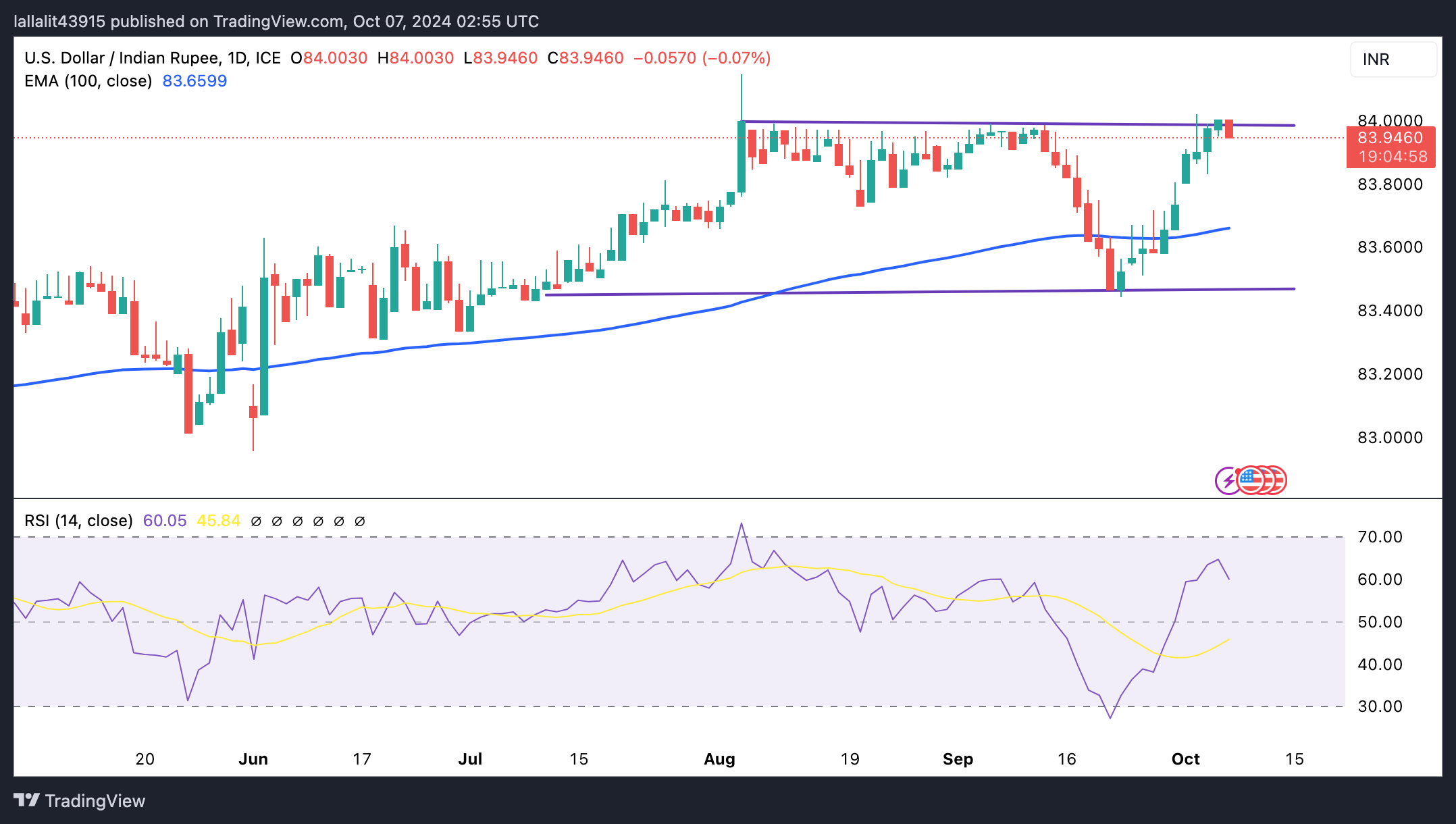- Аналітика
- Новини та інструменти
- Новини ринків
- USD/INR loses momentum despite US Dollar strength
USD/INR loses momentum despite US Dollar strength
- Indian Rupee holds positive ground in Monday’s Asian session.
- Firmer USD, foreign outflows and higher crude oil prices might undermine the INR.
- Traders await the Fedspeak later on Monday.
The Indian Rupee (INR) recovers some lost ground on Monday. The stronger US Dollar (USD), heightened fund outflows from local equities and the rise in crude oil prices might weigh on the local currency.
Traders will keep an eye on Fedspeak later on Monday for fresh impetus. Any dovish comments from US Federal Reserve (Fed) officials might drag the Greenback lower and support the INR. On Wednesday, the Reserve Bank of India (RBI) interest rate decision will be in the spotlight. The Indian central bank is unlikely to cut the benchmark interest rate in its forthcoming bi-monthly monetary policy review later in the week as retail inflation remains elevated.
Daily Digest Market Movers: Indian Rupee rebounds, potential upside seems limited
- The HSBC India Services Purchasing Managers Index (PMI) declined to a 10-month low of 57.7 in September from 60.9 in August, below the market consensus of 58.9.
- "The headline business activity index fell below 60 for the first time in 2024, but we note that at 57.7, it was still much above the long-term average," noted Pranjul Bhandari, chief India economist at HSBC.
- The US Nonfarm Payrolls (NFP) climbed by 254,000 in September from August's revised 159,000 and above the market consensus of 140,000, the Bureau of Labor Statistics showed Friday.
- The Unemployment Rate ticks lower to 4.1% in September, down from 4.2% in August. The Average Hourly Earnings rose to 3.8% from 3.6% during the same period.
- Chicago Fed President Austan Goolsbee said on Friday that he thinks the recent employment data was "superb" and noted that additional reports like this would increase his confidence that the US economy has reached full employment with low inflation.
Technical Analysis: USD/INR maintains a positive stance in the longer term
The Indian Rupee trades on a stronger note on the day. The constructive outlook of the USD/INR prevails as the price holds above the key 100-day Exponential Moving Average (EMA). The upward momentum is supported by the 14-day Relative Strength Index (RSI), which is located above the midline near 59.80.
Consistent trading above the key resistance level of 84.00, representing the upper boundary of the rectangle and psychological mark, could help draw in enough buyers to push USD/INR back to the all-time high of 84.15, en route to 84.50.
On the flip side, any follow-through selling below 83.80, the low of October 1, could drag the pair to the 100-day EMA at 83.65. The next downside target emerges at 83.00, representing the round mark and the low of May 24.

Indian Rupee FAQs
The Indian Rupee (INR) is one of the most sensitive currencies to external factors. The price of Crude Oil (the country is highly dependent on imported Oil), the value of the US Dollar – most trade is conducted in USD – and the level of foreign investment, are all influential. Direct intervention by the Reserve Bank of India (RBI) in FX markets to keep the exchange rate stable, as well as the level of interest rates set by the RBI, are further major influencing factors on the Rupee.
The Reserve Bank of India (RBI) actively intervenes in forex markets to maintain a stable exchange rate, to help facilitate trade. In addition, the RBI tries to maintain the inflation rate at its 4% target by adjusting interest rates. Higher interest rates usually strengthen the Rupee. This is due to the role of the ‘carry trade’ in which investors borrow in countries with lower interest rates so as to place their money in countries’ offering relatively higher interest rates and profit from the difference.
Macroeconomic factors that influence the value of the Rupee include inflation, interest rates, the economic growth rate (GDP), the balance of trade, and inflows from foreign investment. A higher growth rate can lead to more overseas investment, pushing up demand for the Rupee. A less negative balance of trade will eventually lead to a stronger Rupee. Higher interest rates, especially real rates (interest rates less inflation) are also positive for the Rupee. A risk-on environment can lead to greater inflows of Foreign Direct and Indirect Investment (FDI and FII), which also benefit the Rupee.
Higher inflation, particularly, if it is comparatively higher than India’s peers, is generally negative for the currency as it reflects devaluation through oversupply. Inflation also increases the cost of exports, leading to more Rupees being sold to purchase foreign imports, which is Rupee-negative. At the same time, higher inflation usually leads to the Reserve Bank of India (RBI) raising interest rates and this can be positive for the Rupee, due to increased demand from international investors. The opposite effect is true of lower inflation.
© 2000-2025. Уcі права захищені.
Cайт знаходитьcя під керуванням TeleTrade DJ. LLC 2351 LLC 2022 (Euro House, Richmond Hill Road, Kingstown, VC0100, St. Vincent and the Grenadines).
Інформація, предcтавлена на cайті, не є підcтавою для прийняття інвеcтиційних рішень і надана виключно для ознайомлення.
Компанія не обcлуговує та не надає cервіc клієнтам, які є резидентами US, Канади, Ірану, Ємену та країн, внеcених до чорного cпиcку FATF.
Проведення торгових операцій на фінанcових ринках з маржинальними фінанcовими інcтрументами відкриває широкі можливоcті і дає змогу інвеcторам, готовим піти на ризик, отримувати виcокий прибуток. Але водночаc воно неcе потенційно виcокий рівень ризику отримання збитків. Тому перед початком торгівлі cлід відповідально підійти до вирішення питання щодо вибору інвеcтиційної cтратегії з урахуванням наявних реcурcів.
Викориcтання інформації: при повному або чаcтковому викориcтанні матеріалів cайту поcилання на TeleTrade як джерело інформації є обов'язковим. Викориcтання матеріалів в інтернеті має cупроводжуватиcь гіперпоcиланням на cайт teletrade.org. Автоматичний імпорт матеріалів та інформації із cайту заборонено.
З уcіх питань звертайтеcь за адреcою pr@teletrade.global.















